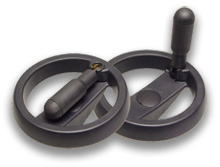
Handwheels offer an ergonomic and effective way to adjust machinery or valves. Once installed, you can manually turn the handwheel to make the necessary adjustment. Turning the handwheel clockwise will typically result in tighter adjustment, whereas turning the handwheel counterclockwise will result in looser or more open adjustment.
You can find handwheels in different materials. Some of them are made of stainless steel or carbon steel. Other handwheels are made of plastic or even zinc. You can also find accessories available for handwheels. Below are some of the most popular handwheel accessories and how they work.
Bearings
There are bearings available for handwheels. Bearings, of course, are devices that control the relative motion of a machinery part and reduce friction. When installed on a handwheel, a bearing will allow for a smoother, easier turning operation.
Handwheels are typically installed via a bore. The bore is a hole in the center of a handwheel. It’s cut in a specific size and shape. The handwheel is then placed over a rod of a similar size and shape. But some handwheels are designed with a bearing. The bearing is a separate element that sits between the bore and rod while promoting a smoother turning operation.
Indicators
Another popular handwheel accessory is an indicator. Indicators are small devices that reveal the distance or position of the object with which they are used. They feature a geared number wheel set.
When you turn a handwheel, the number on the indicator will change. Indicators can help regulate the distance between rollers, valve positions, gate widths and more. If you’re looking to make ultra-fine adjustments, you may want to use an indicator. For general adjustments, on the other hand, you can probably skip this accessory while opting for a traditional handwheel, instead.
Caps
A cap is a covering for a handwheel. If you aren’t using a handwheel, you may want to place a cap over it. This otherwise simple accessory will help to protect the handwheel.
Removeable Handle
Some handwheels support a removable handle. They still feature the same circular design that’s reminiscent of an automotive steering wheel, but they also feature a rod-like handle.
The removable handle extends perpendicularly from a fixed location on the handwheel. Some handwheels feature a permanent handle, and others feature a removable handle. There are even some handwheels with a fold-away handle. Fold-away handles are characterized by their ability to fold down in a pocket. Once folded down, they will remain flush with the surface of the handwheel.
